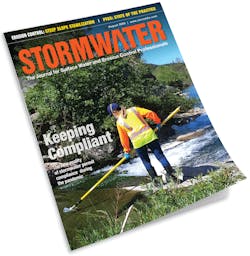To those outside the stormwater and sediment control industries, the work done to preserve surface water quality and reduce erosion and sedimentation can appear rather opaque. Stormwater capture and treatment often occur underground, street sweeping can feel like just a schedule to move your car, and very few people admire a stable slope with the same intensity as they curse one that erodes. As is true with many things, the prevention gets less attention than the failure.
However, sediment control and surface water quality experts know there’s more to the job than a beautifully vegetated slope, an unflooded street, or even a healthy stream. The nitty-gritty behind-the-scenes work yields the results—as unnoticed by the general public as it may be.
This month, we’re bringing you stories exploring some of the background work that goes into maintaining surface water quality and controlling sediment. In our lead feature, “Keeping Compliant during COVID,” David Renfrew discusses EPA’s reporting requirements during the pandemic and the challenges it presents for water regulation entities.
Up in Canada, in order to meet the Alberta Environment and Parks TSS and TP loading objectives, the City of Calgary created a city-wide stormwater model. Check out “A City of Stormwater” for more on how the model was developed and then applied to evaluate scenarios as far into the future as 2078 while considering new development and redevelopment conditions.
Although each site is unique, some need a little more personalized attention than others. In “Designed Drainage,” 100-year-old streets received custom stormwater infrastructure to help alleviate flooding. In “Steep Slope? No Problem!” a 70-degree slope on the shore of Lake Wisconsin needed serious stabilization, but with native plants and pre-vegetated blankets, the results were quick and impressive.
How do you protect one of the world’s greatest national treasures, the Great Barrier Reef? For the city of Cairns, Australia, it starts with understanding your impact. Cairns Regional Council commissioned a network of sensors to better understand what they were discharging to the Reef and alert them to when loads got too high. Check out “Caring for Coral” for more.
Finally, don’t miss our Guest Editorial, which offers an overview of PFAS and the state of the practice. What do we know and what questions still need to be answered? With PFAS already on the radar for soils, sediments, and groundwater, surface water quality standards will likely soon follow.
The work that goes on largely out of public view—to find the best solution, to understand all the variables—is the bulk of the work of stormwater managers and erosion control experts. It’s also the foundation that supports everything else, whether that’s water quality, shoreline stability, or pollutant reduction. As we grapple with changing procedures and the economic fall out of the global COVID-19 pandemic, this strong foundation is what will carry this industry through.
About the Author
Rachel Sim
Editor
As the editor of Stormwater magazine from June 2019 to December 2020, Rachel Sim created and curated quality content addressing the challenges faced by surface water and erosion control professionals, focusing on cutting-edge technology and the latest environmental research.
